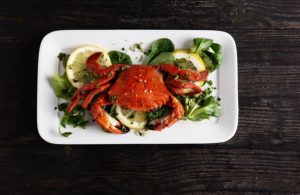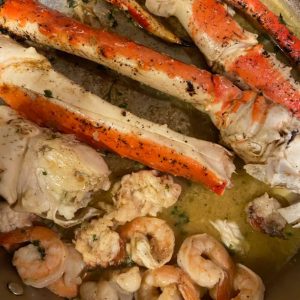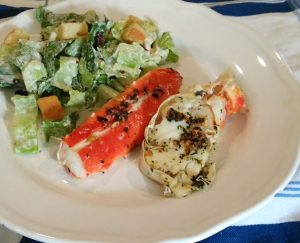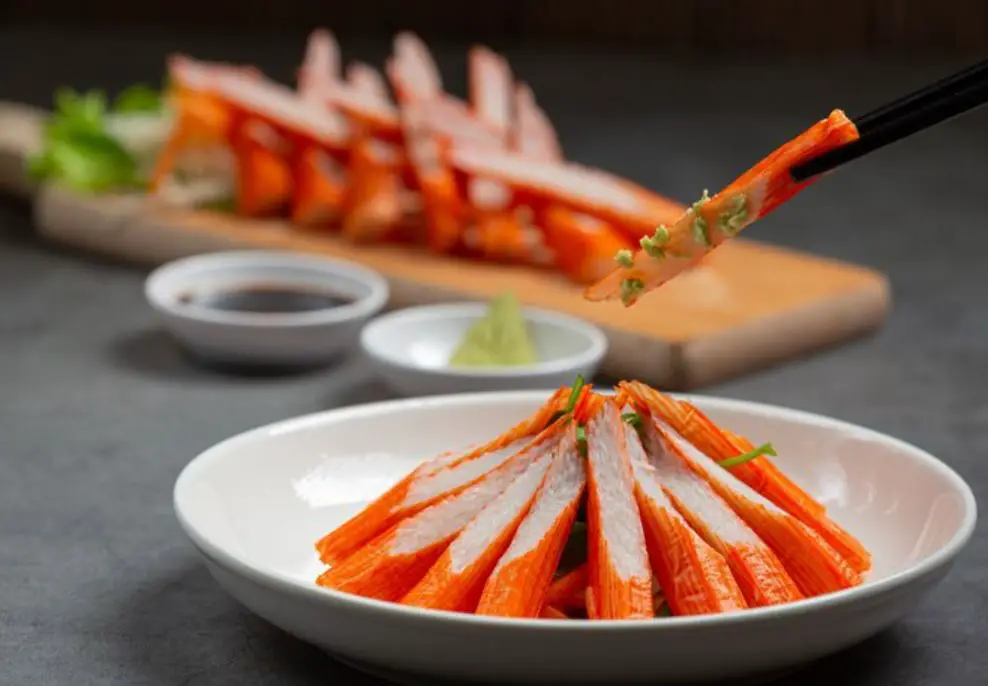Introduction to Cooking Crab Legs
Cooking crab legs is a culinary adventure, offering a delightful seafood experience. Crab legs, known for their succulent meat and elegant presentation, are a favorite among seafood enthusiasts. This guide will explore various methods and tips for cooking crab legs, ensuring a delicious outcome every time.
The Appeal of Crab Legs as a Seafood Delicacy
Crab legs are celebrated for their rich, sweet flavor and tender texture, making them a sought-after delicacy in seafood cuisine. They are not only delicious but also offer a visually impressive addition to any meal. The meat inside the legs is considered a premium part of the crab, often preferred for its delicate taste and ease of eating. Crab legs are versatile and can be prepared in multiple ways, including boiling, steaming, grilling, and baking. This versatility, combined with their luxurious appeal, makes crab legs a popular choice for special occasions and gourmet dining.
Overview of Popular Crab Leg Types: Dungeness, King, and Snow Crabs
There are several types of crab legs, each with unique characteristics. Dungeness crab legs are known for their sweet, mild flavor and tender meat, making them a favorite on the West Coast of the United States. King crab legs, larger and more robust, are prized for their rich, succulent meat and are often considered the most luxurious option. Snow crab legs, smaller and more delicate, offer a sweet and subtly briny flavor, making them a popular choice in many seafood dishes. Each type offers a different culinary experience, allowing for a range of flavors and textures in crab leg dishes.
Selecting the Best Crab Legs
Choosing the right crab legs is crucial for a successful seafood feast. The quality of the crab legs directly impacts the flavor and overall dining experience.
Fresh vs. Frozen Crab Legs: Pros and Cons
When selecting crab legs, one of the main considerations is whether to choose fresh or frozen. Fresh crab legs are often preferred for their superior flavor and texture. However, they can be more expensive and less available, depending on your location and the season. Frozen crab legs, on the other hand, offer convenience and year-round availability. They are typically pre-cooked and flash-frozen, preserving their quality. While some argue that frozen crab legs can lose a bit of their texture and flavor, high-quality frozen crab legs can still provide an excellent dining experience, especially when properly thawed and cooked.
Identifying Quality in Crab Legs
Quality crab legs should have a fresh, oceanic smell, with no hints of ammonia or off-odors. The shells should be intact and glossy, without any discoloration or dry spots. For fresh crab legs, look for a bright, clean appearance and a firm texture. If choosing frozen crab legs, ensure they are solidly frozen with no signs of freezer burn. The size of the crab legs can also be a consideration, with larger legs often offering more meat. However, smaller legs can be just as flavorful and are sometimes preferred for certain recipes.

Preparation Before Cooking
Proper preparation is key to ensuring the best flavor and texture when cooking crab legs. This involves thawing frozen crab legs correctly and cleaning them before cooking.
Proper Thawing Techniques for Frozen Crab Legs
Thawing frozen crab legs correctly is crucial for maintaining their quality and texture. The best method is to place them in the refrigerator for 8-12 hours or overnight. This slow thawing process helps preserve the crab legs’ delicate texture. Avoid thawing crab legs at room temperature or under warm water, as this can lead to a loss of flavor and a mushy texture. If you’re short on time, you can thaw crab legs under cold running water, but ensure the water is not too powerful to avoid damaging the meat.
Cleaning and Prepping: A Step-by-Step Guide
Once thawed, rinse the crab legs under cold water to remove any ice crystals or debris. Check for any damaged or broken shells and remove them. If the crab legs have long spikes, you can trim them for easier handling. Some prefer to crack the legs slightly before cooking to allow flavors to penetrate and make them easier to eat after cooking. However, be gentle to avoid extracting the meat from the shell prematurely.
Boiling Crab Legs: A Traditional Method
Boiling is a popular and straightforward method for cooking crab legs, preserving their natural flavor and juiciness.
Detailed Instructions for Boiling
To boil crab legs, fill a large pot with enough water to cover the crab legs. Add salt and other seasonings like lemon, garlic, or bay leaves for added flavor. Bring the water to a rolling boil, then carefully add the crab legs. Reduce the heat slightly and let them simmer for about 5-7 minutes for thawed crab legs or 10-12 minutes for frozen. The crab legs are done when they are heated through, and the color turns bright red.
Tips for Perfectly Cooked Crab Legs
Avoid overcooking crab legs, as this can make the meat tough and rubbery. Use tongs to remove the crab legs from the water and serve immediately. If you’re not serving them right away, submerge them in cold water to stop the cooking process and keep them warm in a low oven until ready to serve.
Steaming for Optimal Flavor
Steaming crab legs is an excellent method to retain their natural flavors and moisture.
How to Steam Crab Legs
To steam crab legs, fill a pot with a few inches of water, add a steamer basket, and bring the water to a boil. Place the crab legs in the basket in a single layer, ensuring they have enough room for the steam to circulate. Cover the pot and steam for about 5-8 minutes for thawed crab legs or 10-15 minutes for frozen. The crab legs are ready when they are heated through and the shell turns bright red.
Seasoning Ideas and Techniques
Enhance the flavor of steamed crab legs by adding seasonings to the steaming water. Herbs like dill, parsley, or thyme, spices like Old Bay, or aromatics like garlic or lemon slices can infuse the crab legs with additional flavors. You can also brush the crab legs with melted butter or olive oil mixed with herbs and spices before steaming for an extra flavor boost.

Sous Vide Cooking: Precision and Flavor
Sous vide cooking offers a unique way to prepare crab legs, ensuring precise temperature control and enhanced flavor.
Setting Up for Sous Vide
To cook crab legs sous vide, you’ll need a sous vide machine or immersion circulator and a large pot or container to hold water. Fill the container with water and set the sous vide machine to the desired temperature, typically around 135°F to 140°F (57°C to 60°C) for crab legs. Place the crab legs in a vacuum-sealed bag or a zip-lock bag using the water displacement method. Ensure the crab legs are in a single layer for even cooking.
Flavor Infusion Techniques
Sous vide cooking allows for deep flavor infusion. Add seasonings like lemon slices, garlic, herbs, or a small amount of butter into the bag with the crab legs. The sealed environment will intensively infuse the crab legs with these flavors during cooking. Cook the crab legs for about 45 minutes to an hour. Once done, they can be served immediately or quickly seared or grilled for added texture.
Baking Crab Legs in the Oven
Baking is a fuss-free method to cook crab legs, resulting in tender and flavorful meat.
Oven Temperature and Timing
Preheat your oven to 350°F (175°C). Arrange the crab legs in a single layer on a baking sheet or in a baking dish. If the crab legs are large, you may need to bend or break them at the joints to fit. Baking time varies depending on the size and whether the crab legs are fresh or thawed. Generally, bake for about 15-20 minutes for thawed crab legs or 25-30 minutes for frozen.
Preparing and Seasoning for Baking
Before baking, you can brush the crab legs with melted butter or olive oil and sprinkle them with your choice of seasonings, such as garlic powder, paprika, or a seafood seasoning blend. Cover the baking sheet with aluminum foil to keep the moisture in and prevent the crab legs from drying out.
Grilling Crab Legs for a Smoky Flavor
Grilling crab legs imparts a delightful smoky flavor and a slightly charred texture.
Grilling Techniques and Tips
Preheat your grill to medium-high heat. If the crab legs are large, you might need to cut them into smaller, manageable sections. Brush the grill grates with oil to prevent sticking. Place the crab legs directly on the grill and cook for about 4-5 minutes on each side. The high heat will quickly heat the crab legs through and give them a slightly smoky flavor.
Marinades and Rubs for Grilled Crab Legs
For added flavor, marinate the crab legs for about an hour before grilling. Use marinades like lemon-garlic butter, herbed olive oil, or a spicy Cajun-style marinade. Alternatively, you can apply a dry rub of your choice. After grilling, you can also brush the crab legs with additional melted butter or your marinade for extra flavor and richness.

How To Cook Crab Legs
Cooking crab legs is a straightforward process, especially since most crab legs are sold pre-cooked and frozen. The primary goal is to heat them thoroughly while maintaining their succulence and flavor. Here’s a simple guide on how to cook crab legs:
Ingredients:
- Crab legs (King, Snow, or Dungeness, typically pre-cooked and frozen)
- Water (for boiling or steaming)
- Salt (optional, for boiling water)
Equipment:
- Large pot
- Steamer basket (if steaming)
- Tongs
- Kitchen scissors or crab crackers (for serving)
Methods of Cooking:
Boiling:
- Fill a Large Pot with Water:
- Fill a large pot with enough water to cover the crab legs. Add a pinch of salt if desired.
- Bring to a Boil:
- Bring the water to a rolling boil over high heat.
- Add the Crab Legs:
- Using tongs, carefully place the crab legs into the boiling water. You might need to bend them at the joints to fit them in the pot.
- Cook:
- Boil for about 4-6 minutes if thawed, and a few minutes longer if frozen.
- Remove and Serve:
- Use tongs to remove the crab legs from the water. Serve hot with melted butter and lemon wedges.
Steaming:
- Fill Pot with Water:
- Fill a pot with about an inch of water. Bring the water to a boil.
- Place Crab Legs in Steamer Basket:
- Place a steamer basket in the pot and add the crab legs to the basket.
- Cover and Steam:
- Cover the pot and steam for about 5-7 minutes if thawed, a bit longer if frozen.
- Remove and Serve:
- Carefully remove the crab legs and serve as desired.
Baking:
- Preheat Oven:
- Preheat your oven to 350°F (175°C).
- Prepare Crab Legs:
- Place the crab legs in a single layer on a baking sheet. You can brush them with melted butter or olive oil if desired.
- Bake:
- Bake for about 8-10 minutes, or until heated through.
- Remove and Serve:
- Take them out of the oven and serve.
Grilling:
- Preheat Grill:
- Preheat your grill to medium-high heat.
- Prepare Crab Legs:
- Brush the crab legs with oil or melted butter.
- Grill:
- Place the crab legs on the grill and cook for about 4-5 minutes on each side.
- Remove and Serve:
- Take them off the grill and serve.
Tips:
- Crab legs are often sold pre-cooked, so your main goal is to heat them through without drying them out.
- Serve with melted butter, lemon wedges, and perhaps a sprinkle of herbs or garlic for added flavor.
- Use kitchen scissors or crab crackers to help crack the shells and extract the meat.
Enjoy your deliciously cooked crab legs, a luxurious and flavorful seafood treat that’s perfect for special occasions or a decadent meal at home!
FAQs About How To Cook Crab Legs
What is the best way to cook crab legs?
The best way to cook crab legs depends on personal preference. Boiling and steaming are popular methods that preserve their natural flavor and tenderness. Baking and grilling offer a more robust flavor with a smoky or crispy texture.
Is it better to boil or steam crab legs?
Both boiling and steaming are excellent methods. Steaming is slightly better for retaining the crab legs’ natural flavor and texture, while boiling is quicker and allows for easy flavor infusion with seasonings in the water.
How to cook crab for beginners?
For beginners, steaming is a straightforward and effective method. Simply steam the crab legs in a pot with a few inches of water, seasoned with salt, lemon, and garlic, for about 5-10 minutes until heated through.
Is it better to boil or steam snow crab legs?
Steaming is generally preferred for snow crab legs as it gently cooks them, preserving their delicate flavor and texture. Boiling is also a good option, especially for infusing additional flavors, but care must be taken not to overcook.
Conclusion
Cooking crab legs can be a simple yet rewarding culinary experience. Whether steamed, boiled, baked, or grilled, each method offers unique flavors and textures. The key is to preserve the natural delicacy of the crab while enhancing it with complementary seasonings, ensuring a delightful seafood feast.


